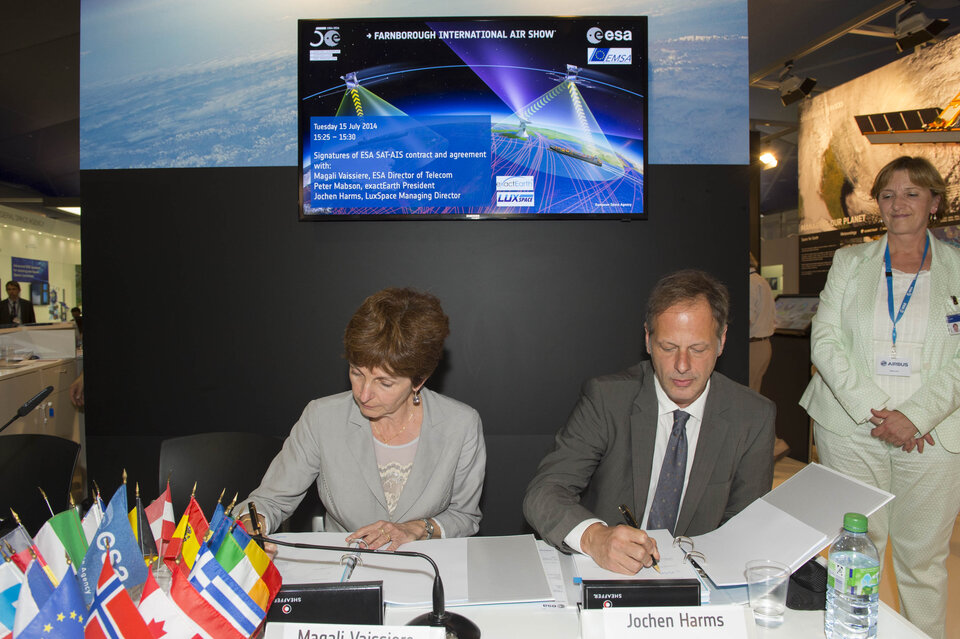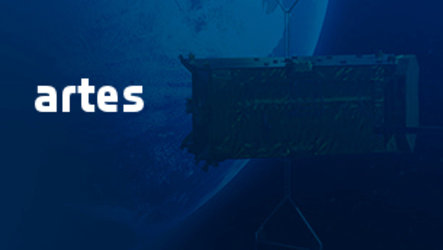Boosting marine traffic monitoring via satellite
ESA will improve the identification and tracking of seafaring vessels anywhere on Earth from 2018 under a public–private partnership with LuxSpace of Luxembourg and exactEarth of Canada, signed today at the UK’s premier airshow.
Existing marine traffic control, which is based on radio links, is limited to coastal areas and even near shore can still have signal gaps. The system was originally developed to prevent collisions but it now also tracks ships to help prevent pollution, aids in the movement of dangerous goods and offers routine surveillance.
Large vessels and all passenger ships irrespective of size are mandated by the International Maritime Organization to carry Automatic Identification System (AIS) equipment. It transmits the course and speed as well as identification and position information to other vessels and shore stations.
While AIS has been deployed globally, it suffers from a major limitation because Earth’s curvature limits its horizontal range to about 74 km from shore. This means that AIS traffic information sent out by ship beacons is available only around coastal zones or on a ship-to-ship basis.
Satellites are the answer: the ship’s identity and position are recorded by satellite then sent to ground stations for processing and distribution.
ESA is promoting ‘SAT-AIS’ in partnership with the European Maritime Safety Agency to meet the requirements of users, particularly those of government agencies such as coastal administrations.

The development contract for Phase-B2/CD of one SAT-AIS microsatellite with an option for a second was signed on 15 July at the UK’s Farnborough International Airshow by Magali Vaissiere, ESA’s Director of Telecommunications and Integrated Applications, and Jochen Harms, Managing Director of the prime contractor, LuxSpace S.a.r.l. of Luxembourg.
“This programme is an excellent example of a public–private partnership, driven by industry, for the development and exploitation of a constellation of microsatellites,” noted Mrs Vaissiere.
For these next-generation services, LuxSpace will design and build the 60 x 60 x 70 cm, 100 kg microsatellite, aiming for launch in 2018.
“This programme is an important step for LuxSpace to further develop its product line for the global commercial and institutional market,” said Jochen Harms.

The Canadian operator exactEarth will be responsible for its mission definition, ground segment, launch and operation. The agreement between ESA and exactEarth was signed at Farnborough by Magali Vaissiere and Peter Mabson, President of exactEarth Ltd.
“This agreement represents a major milestone in the development of a leading-edge maritime monitoring system for Europe, establishing the groundwork for long term joint collaboration between ESA, LuxSpace and exactEarth,” commented Mr Mabson.
“Under this agreement, exactEarth is making major investments in Europe through its Harwell, UK subsidiary, exactEarth Europe, who will own and operate these satellites and develop advanced maritime applications for the global market.”
Based on a payload development under ESA’s ARTES programme, the Norwegian Space Centre launched the AISSat-1 nanosatellite in 2010 to demonstrate the reception of AIS signals. Building on this, ESA and the space centre are working on a novel AIS payload to be carried on Norway’s next satellite, Norsat-1. The development contract with Kongsberg Seatex was signed in February 2014.
“The development of an advanced AIS payload in ARTES for Norsat-1 will open new possibilities for the nationally controlled ship monitoring in the extended arctic waters of Norway, and in addition the payload developed by Kongsberg Seatex will enhance the capability of the exactEarth/LuxSpace mission,” said Bo Andersen, Director General of the Norwegian Space Centre.
“For ESA and the supporting Member States, SAT-AIS is a very promising field of applications. Both projects encompass novel, advanced payloads and an improved microsatellite platform combined with a cost-effective approach,” noted ESA’s Carsten Tobehn.





